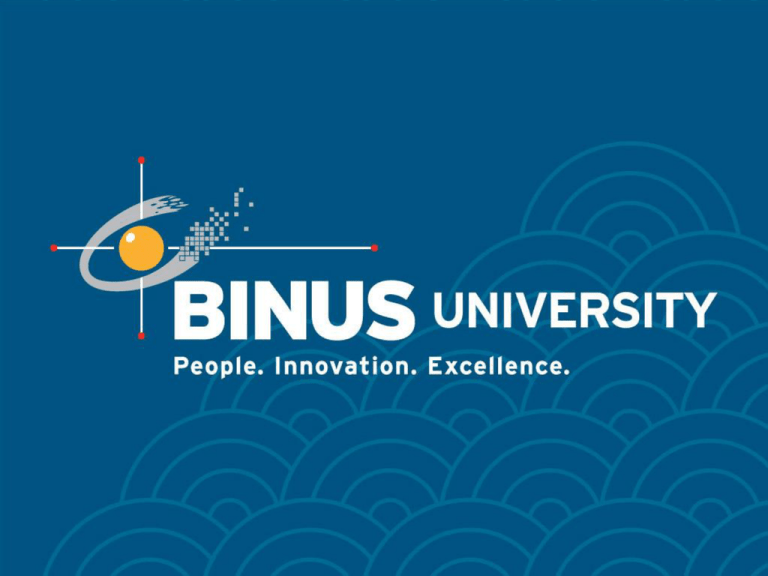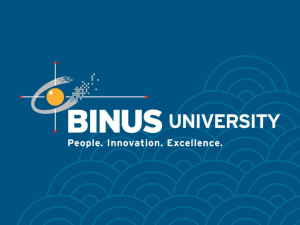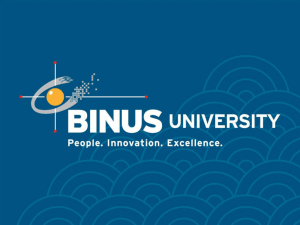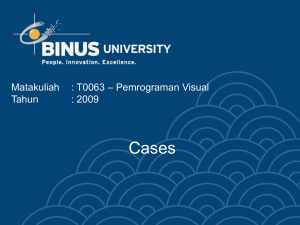Document 15063071
advertisement

Course Name: Business Intelligence Year: 2009 Business Models and Information Flow 10th Meeting Source of this Material (2). Loshin, David (2003). Business Intelligence: The Savvy Manager’s Guide. Chapter 5 Bina Nusantara University 3 The Business Case After the system is built it is critical to have a blueprint of the way that information flows into and out of the system to provide a tracking mechanism to back up any conclusions that are drawn through data analysis • The Information Factory • The Value Modeling Information Flow • Design versus Implementation • Benefits of The Business Process Model An information flow, as embodied as part of a business process model, provides the following benefits. Developed Road Map Operational Road Map Management Control Calculation of Return on Investment (ROI) Bina Nusantara University 4 Information Processing and Information Flow In this section we look at a number of different kinds of processing paradigms and how we can view a business application. • Transaction Processing Operations in a transaction processing system are interactions between a user and a computer system where there is the perception of an immediate response from the system to the user’s requests. A commonly encountered example of transaction processing is the use of an automated teller machine (ATM). A rough view of ATM information flow can be seen in Figure 10-1. • Operational Processing Operational process information flows are likely to connect heavy sequential operational processing augmented by lightweight interconnections for exchanging control information. Bina Nusantara University 5 Information Processing and Information Flow (cont…) Figure 10-1 Bina Nusantara University 6 Information Processing and Information Flow (cont…) • Batch Processing Batch processing takes collections of sequences of similar operations that are to be executed in batches. A batch processing application is more likely to apply each processing stage to a set of data instances as a whole and then push the results to the next processing stage. A rough view of a batch processing information flow can be seen in Figure 10-2. • Analytical Processing Analytical processing involves the interaction between analysts and collections of aggregated data that may have been reformulated into alternate representational forms as a means for improved analytical performance. A sketch of the information flow for analytical processing can be seen in Figure 10-3. Bina Nusantara University 7 Information Processing and Information Flow (cont…) Figure 10-2 Bina Nusantara University Figure 10-3 8 The Information Flow Model An information flow model distinguishes the discrete processing stages within the process, describes how information flows through that system, and characterizes the kinds of data items that flow through the process. • Information Flow: Processing Stages In an information flow model, we distinguish discrete processing stages. Although the following list is by no means complete, we can characterize each processing stages as one of these classes. • Supply • Acquire • Transform • Create • Process • Package • Switch/Route • Decide • Portal Bina Nusantara University 9 The Information Flow Model (cont…) • Consume • Information Flow: Directed Channels Data moves between stages through directed information channels. A directed information channel is a pipeline indicating the flow of information from one processing stage to another, indicating the direction in which data flows. • Data Payload Characteristics The last aspect of an information flow model is the description of the data items that are propagated between any pair of processing stages. The characteristics include the description of the information structure (i.e., columnar attribution), the size of the data instances, and the cardinality of the data set (i.e., the number of records communicated) Bina Nusantara University 10 Usage in Practice This section provides a few examples where value can be derived from modeling business process and information flows. • Information Valuation Use of a business process model to guide the determination of metrics appropriate for measuring the value of data as well as indentifying the locations for the insertion of monitors to collect those measurements. • Root Cause Analysis One example of the use if an information flow model is in identifying the source of a data quality problem. The effects of a data quality problem might manifest themselves at different stages within an information flow, perhaps at different data consumption stages. • Operational Performance Improvement Another use of an information flow model is to gauge both the strict control and data dependencies within the system, and the performance behavior for transferring data between processing stages as well as processing at each stage. Bina Nusantara University 11 Modeling Frameworks Conceptual business process and information flow modeling can be actualized in different ways, some formal frameworks used for information and activity modeling: • Use Case Analysis A use case model specifies the function of a system and describe what the system should offer from the user’s perspective, using three components. Actors Use Cases Triggers • Unified Modeling Language UML can be used to develop business process and information flow models, especially because it has a facility for describing system behavior. In particular, state machines and activity graphs can be used to model process stage interaction. Bina Nusantara University 12 Modeling Frameworks (cont…) • Integrated Definition Language Figure 10-4 Integrated Definition Language (IDEF) is a modeling language designed to describe functional processing and information flows. It comprises two descriptive standards: IDEF0, which is used to describe activity models, and IDEF1X for describing data models. The basic IDEF0 activity modeling object in an IDEF model is referred to as an ICOM, an acronym for “input, control, output, and mechanism.” A general ICOM object can be seen in Figure 10-4. Bina Nusantara University 13 Management Issues Probably the most critical management issue associated with business process and information flow modeling is the disconnect between the representation of the model and the actual implementation. There must be frequent synchronization between the documented model and the actual system itself. Bina Nusantara University 14 End of Slide Bina Nusantara University 15


